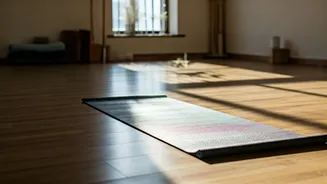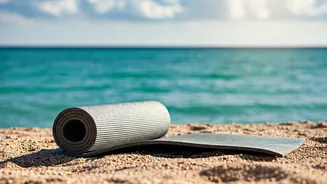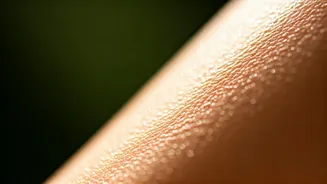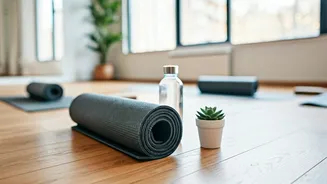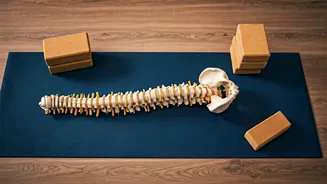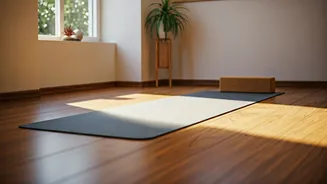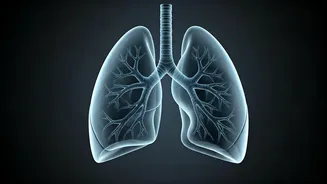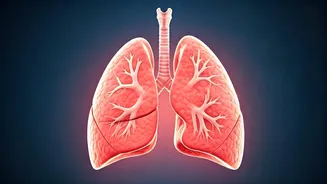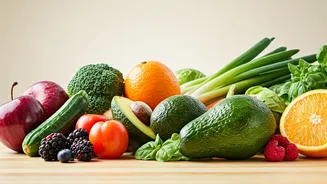Embracing Bhujangasana
Bhujangasana, or Cobra Pose, is a foundational yoga asana, typically practiced in a sequence of movements. To perform this pose, one begins by lying flat
on their stomach, with legs extended and the tops of the feet resting on the floor. Hands are positioned beneath the shoulders, palms flat, with fingers spread. As you inhale, slowly lift the head and chest off the ground, using your back muscles, not just your arms, to arch the spine. The gaze should be directed forward or slightly upward. Keep your shoulders relaxed and away from your ears, and engage the core to support your lower back. Hold the pose for several breaths, focusing on lengthening the spine and opening the chest. Exhale slowly as you return to the starting position. Regular practice of Bhujangasana is often associated with improved flexibility in the spine, strengthening of the back muscles, and enhanced digestion. This pose can also help to alleviate stress and fatigue, fostering a sense of overall well-being. Additionally, the gentle stretch can contribute to improved posture and a more youthful appearance by counteracting the effects of slouching.
Mastering Matsyasana
Matsyasana, or Fish Pose, is a gentle backbend that typically follows shoulder-stand asanas in a yoga sequence. To assume this posture, one starts by lying on their back. Then, one supports the body with their elbows, gently arching the back to lift the chest while the head gracefully rests on the floor, ideally. The arms may be extended to the sides or overhead, palms up, depending on comfort. The pose expands the chest, encouraging deeper breathing. Hold the pose for several breaths. This asana stretches the muscles in the abdomen and neck, and it is known to stimulate the thyroid and parathyroid glands. Matsyasana can alleviate fatigue and relieve stress, and it is considered beneficial for respiratory issues. Its gentle stretching effect on the neck area may also provide relief from stiffness and tension. The emphasis on opening the chest can help to promote better oxygen flow, contributing to an overall sense of rejuvenation and vitality.
Sarvangasana's Influence
Sarvangasana, commonly known as the Shoulder Stand, is a pose frequently incorporated in yoga routines. To begin, one lies on their back with the legs extended. The body is then lifted, supporting the weight on the shoulders, with the elbows providing stability on the ground and the hands supporting the back. The legs are extended upwards, forming a straight line with the torso. The gaze is directed towards the toes. Sarvangasana is celebrated for its numerous health advantages. It supports blood circulation, which, in turn, can help to nourish the skin. It stimulates the thyroid gland, which controls metabolism, potentially contributing to a healthy complexion. In addition, this inversion pose can relieve stress and improve mental clarity. The sustained effort needed to maintain this posture also strengthens the core muscles, assisting in maintaining posture. The Shoulder Stand is often viewed as a fountain of youth in yoga, because it affects circulation and the health of key glands.
Adho Mukha Svanasana's Benefits
Adho Mukha Svanasana, often called Downward-Facing Dog, is a staple pose within any yoga sequence. This pose begins on hands and knees. The hands are placed shoulder-width apart, and the fingers spread wide, firmly grounded into the mat. The toes are tucked under, and the knees lift off the floor. The body forms an inverted V shape. One’s heels ideally reach for the ground, though this varies depending on flexibility. The head hangs between the upper arms, relaxing the neck. The aim is to lengthen the spine, stretching from the hands to the tailbone. Adho Mukha Svanasana provides a comprehensive body stretch. It revitalizes the body by improving blood circulation, thereby promoting a healthy glow, and possibly aiding the skin. It can alleviate tension in the shoulders and back. In addition, the inversion can calm the brain and help relieve stress and mild depression, contributing to a more relaxed and rejuvenated appearance. The invigorating nature of this asana ensures improved energy levels.
Vajrasana's Tranquility
Vajrasana, or Thunderbolt Pose, is a seated meditation posture. To assume this position, one kneels on the floor, keeping the knees together. The toes are tucked under, and the buttocks rest on the heels. The hands rest on the thighs or knees, palms down, or the hands can be in a mudra (hand gesture) related to meditation. The back should be straight, but the shoulders relaxed. Vajrasana is particularly beneficial for digestion, as it helps increase blood flow to the lower abdomen. It is often recommended after meals to aid in the digestive process, potentially assisting in the absorption of nutrients. The pose also helps in relieving stress and promoting mental clarity, creating a state of inner peace and serenity. This calming effect can contribute to a more relaxed and youthful appearance, as stress is a contributing factor to visible aging. In addition, it is thought to strengthen the muscles of the legs.
Tadasana's Foundation
Tadasana, or Mountain Pose, seems simple at first glance, but is a fundamental asana. To perform Tadasana, one stands with feet together or slightly apart, grounding through the four corners of the feet. The body is upright, and the weight is evenly distributed. The core engages gently, and the spine lengthens upward. The arms hang relaxed at the sides, with the palms facing forward. The shoulders are relaxed and away from the ears. The gaze is forward, and the breath is even and steady. Tadasana is the foundation for all standing poses. It assists in developing good posture, which is key to appearing youthful. Its benefits include improved balance and alignment, which prevent future injuries. Practicing Tadasana is a way of developing awareness of the body. By engaging your muscles correctly, you are less likely to slouch, contributing to better posture. It can also help relieve stress and promote a sense of groundedness, supporting an overall feeling of well-being.
